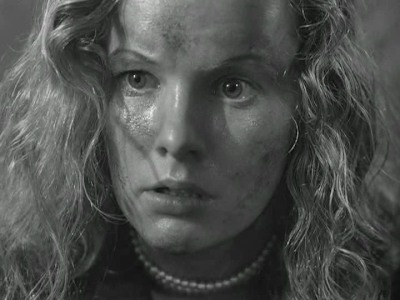Gun Crazy could just as easily be known as Car Crazy, or better still, Wheels Crazy, because the two leads, Bart and Laurie spend lesser time in sticking-up than in making a getaway. Lewis expounds on their shared severe infatuation with weaponry – ‘We are together like’, Bart pauses and then pursues, ‘like gun and ammunition.’ It is the only analogy he is capable of. But while both the leads are obviously turned on by the smell of gunpowder, gasoline seems to do the job just as well. They spend most of the film driving, and both of them are darned good drivers, with Laurie having to use her entire tiny frame to propel the steering in a certain direction. Infact, it is only when they are not enclosed within the framework of a vehicle that they begin seeming dreadfully vulnerable – regardless of whether they possess their guns or not.
Lewis uses the enormous time spent by the narrative in just lingering inside a car to make a major aesthetic departure from how scenes set inside a car were shot back in the day. By mounting the camera atop a jockey saddle in the back of the car, he shoots the occupants of the car from behind, instead of shooting them from the front with rear projection behind them. We see bona-fide American urban scenery through the windshield, the same as the actors do as they take a turn, or navigate through a rush hour – thereby effectively making us accomplices in their criminal spree by placing us in the backseat of the car. A simple jump across the axis elevates us to being adventurers, from being witnesses to an adventure.
 |
| This is how they do it in Third-Person Shooters |
Despite its blatantly stated moral dilemmas (the proverbial American indecision between uppity ideals and the extent of their applicability; or how it’s possible to tweak them as per convenience) Gun Crazy is primarily a statement on the nature of urge.
Both the leads are gun-toting robbers, but Bart’s (John Dall by the way of James Dean) definition of his urge (or craze) is accurate – he shoots guns because he likes to shoot guns, while Laurie (Cummins, firebrand) shoots guns because of the authorial potency they afford her. Therefore, while Bart is satisfied shooting at empty cans, bottles, and circus-balloons, Laurie needs to point them at human beings to consummate their real ability as she understands it.
 |
| Bowling for Columbine (2002) / Michael Moore |
Her immoral influence as the corruptor of Bart’s small-town ideals make her a distant cousin of The Woman from the City, played by Margaret Livingstone in Murnau’s Sunrise. While Gun Crazy is clearly a tragedy – it is not one because the leads kill each other in the end (such relentless craze cannot but annihilate everything, in that it ends like Kiss Me Deadly) but because of the things that the annihilation renders incomplete. Their love story, most definitely, but also Laurie’s moral journey – she is a femme-fatale blooming into a heroine when she is shot dead by her own lover. She dies half-virgin, half-whore.






No comments:
Post a Comment